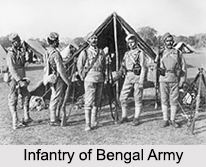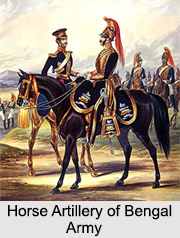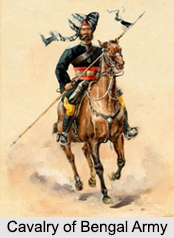 The Bengal Army was the armed forces of Bengal Presidency and one of the three major Presidency Armies in British India. The British Presidency Armies belonged to the British East India Company until the Great Revolt of 1857, also known as Sepoy Mutiny. Later the British Empire took control over the British East India Company and the three Presidency Armies, namely the Bengal Army, the Madras Army and the Bombay Army. In the year 1895, the three separate presidency armies were united to form the combined British Indian Army. Even though the Bengal Army was based in the province of Bengal in eastern India, it extended over the northern Indian Himalayan Mountains and to the North West Frontier Province (now known as the Khyber Pakhtunkhwa).
The Bengal Army was the armed forces of Bengal Presidency and one of the three major Presidency Armies in British India. The British Presidency Armies belonged to the British East India Company until the Great Revolt of 1857, also known as Sepoy Mutiny. Later the British Empire took control over the British East India Company and the three Presidency Armies, namely the Bengal Army, the Madras Army and the Bombay Army. In the year 1895, the three separate presidency armies were united to form the combined British Indian Army. Even though the Bengal Army was based in the province of Bengal in eastern India, it extended over the northern Indian Himalayan Mountains and to the North West Frontier Province (now known as the Khyber Pakhtunkhwa).
The Bengal Army included the most prominent units in British India such as the Corps of Guides on the Khyber Pakhtunkhwa, the Gurkhas from the Himalayas and Skinner`s Horse from Bengal. The Government of India Act 1858, which was authorized after the Sepoy Mutiny in the year 1857, transferred the authority of the three Presidency Armies to the British Empire in India. During the late 19th century, the presence of Bengali members in the army was decreased due to their perceived role as rebels and participation in the Indian rebellion of 1857. Later in the year 1903, the three Presidency Armies in British India were amalgamated in order to form the unified British Indian Army.
Origin of Bengal Army
The Bengal Army originated with the establishment of a European Regiment in 1756. When the East India Company had previously maintained a small force of Dutch and Eurasian mercenaries in Bengal, this was destroyed when Calcutta was captured by the Nawab of Bengal on 30th June in the same year.
In 1757 the first locally recruited unit of Bengal sepoys was created in the form of the Lal Paltan battalion. It was recruited from Bhumihar, Bihari, Rajputs and Pathan soldiers that had served in the Nawab`s Army from Bihar and the Awadh (Oudh) as well as Bengal. Drilled and armed along British army lines, this force served well at the Battle of Plassey in 1757 and twenty more Indian battalions were raised by 1764. The EIC steadily expanded its Bengal Army and by 1796 the establishment was set at three battalions of European artillery, three regiments of European infantry, ten regiments of Indian cavalry and twelve regiments (each of two battalions) of Indian infantry.
Units of Bengal Army
The Bengal Army of British India consisted of several regiments including Cavalry, Artillery, Engineering, Infantry and others. These are discussed below:
Cavalry of Bengal Army: Cavalry had two regiments- regular and irregular regiments:
Regular Regiments:
Governor General`s Bodyguard
1st to 10th Bengal Light Cavalry Regiments.
1st to 4th Bengal European Light Cavalry Regiments.
Irregular Regiments:
1st Irregular Cavalry (Skinner`s Horse)
2nd to 18th Irregular Cavalry Regiments
Jodhpore Legion Cavalry
Bundelkhand Legion Cavalry
Gwalior Contingent Cavalry
Kotah Contingent Cavalry
Bhopal Contingent Cavalry
United Malwa Contingent Cavalry
Ramgarh Irregular Cavalry
Nagpore Irregular Cavalry
1st to 3rd Oudh Irregular Cavalry Regiments
1st, 2nd and 3rd Regiments of Hodson`s Horse
1st to 4th Sikh Irregular Cavalry Regiments
The Jat Horse Yeomanry
Rohilkhand Horse
The Muttra Horse
Alexander`s Horse
Barrow`s Volunteers
Behar Irregular Cavalry
Belooch Horse
Benares Horse
Bengal Yeomanry Cavalry
Calcutta Volunteer Guards
De Kantzow`s Irregular Cavalry
Graham`s Horse
2nd Gwalior Cavalry
2nd Gwalior Mahratta Horse
H.H. The Guicowar`s Horse
Jackson`s Volunteer Horse
Jellandhar Cavalry
Lahore Light Horse
1st Mahratta Horse
Meerut Light Horse
Peshawar Light Horse
Rajghazi Volunteer Cavalry
The Volunteer Cavalry
Lind`s and Cureton`s Risalahs of Pathan Horse
2nd Mahratta Horse
Fane`s Horse
The Corps of Guides, Punjab Irregular Force
1st to 5th Regiments of Cavalry of the Punjab Irregular Force
 Artillery of Bengal Army:
Artillery of Bengal Army:
Bengal Horse Artillery- First Troop, Bengal Horse Artillery; Second Troop, Bengal Horse Artillery; Third Troop, Bengal Horse Artillery; Shah Sujah`s Troop, Bengal Horse Artillery; The Rocket Troop, Bengal Horse Artillery; Bengal European Foot Artillery; Bengal Native Foot Artillery; 5 Company, Third Battalion, Bengal Artillery; Punjab Horse Artillery, Punjab Irregular Force.
Bengal European Foot Artillery
Bengal Native Foot Artillery- 5 Company, 3rd Battalion, Bengal Artillery
Punjab Horse Artillery.
Engineers of Bengal Army:
Corps of Bengal Sappers and Miners
Sebundy Sappers and Miners
Infantry of Bengal Army: Infantry also has regular and irregular regiments:
Regular Regiment:
1st Bengal (European) Fusiliers
2nd Bengal (European) Fusiliers
3rd Bengal (European) Light Infantry
4th, 5th and 6th Bengal European Regiments
1st to 74th Regiments of Bengal Native Infantry.
Irregular Regiment:
Alipore Regiment
Ramgarh Light Infantry
3rd Local Battalion
Sirmoor Rifle Regiment
Kamaoon Battalion
1st Assam Light Infantry
11th Sylhet Local Light Infantry
The Mhairwara Battalion
2nd Assam Light Infantry
Joudpore Legion
Oudh Irregular Force
Narbudda Sebundy Corps
Shekhawati Battalion
Harianna Light Infantry
Regiment of Khelat-i-Gilzie
Malwa Bheel Corps
Kotah Contingent
Mehidpore Contingent
Gwalior Contingent
Malwa Contingent
Bhopal Contingent
Regiment of Ferozepore
Regiment of Ludhiana
Camel Corps
Nusseree Battalion
Nagpore Irregular Force
Deoli Irregular Force
Regiment of Lucknow
Mhair Regiment
Kamroop Regiment
Landhoor Rangers
Kuppurthala Contingent
1st and 2nd Gwalior Regiments
Allahabad Levy
Shahjehanpur Levy
Cawnpore Levy
Fatehgarh Levy
Moradabad Levy
Mynpoorie Levy
Sealkote Infantry Levy
Bareilly Levy
Goojramwallah Levy
Meerut Levy
Kumaon Levy
Agra Levy
Cole and Sonthal Levy
Rajpoot Levy
Loyal Purbeah Regiment
Corps of Guides, Punjab Irregular Force
1st to 4th Sikh Infantry Regiments of the Punjab Irregular Force
1st to 6th Punjab Infantry Regiments of the Punjab Irregular Force
7th to 24th Regiments of Punjab Infantry
 Black Hole Tragedy
Black Hole Tragedy
The Black Hole of Calcutta was a small prison inside the Fort William complex, where army of Siraj-ud-Daulah, the Nawab of Bengal, captured the British prisoners of the war, which took place on 20th June 1756. According to John Zephaniah Holwell, one of the British prisoners and an employee of the East India Company, after the fall of Fort William, the surviving British soldiers, Anglo-Indian soldiers, and Indian civilians were imprisoned overnight in a very small prison. 143 prisoners out of 164 were died due to extreme suffocation and exhaustion of heat in that prison. This became a historical event that is recalled even today in Bengal history.



















